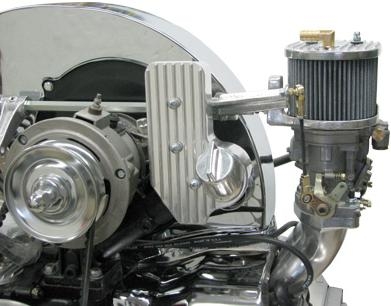Joel! Bit colder now then when we were wandering around Lime Rock, huh?
Anyway, to your questions. ANY engine larger than a 1,776cc needs additional breather assistance. The stock VW breather apparatus (if you can call it that) was barely adequate for their 1,600. The 356 version was slightly larger (more like a Berg or CSP breather) and the 356 racers concocted a bunch of different versions, the best ones based on a large (think Hi-C) juice can. Danny P has a cool one (and pretty effective, too) on his Spyder that is an 18" long by 2-1/2"-ish diameter cylinder and plumbed to the case and vented to the carbs.
The question becomes, "what sort of breather set-up do I need for my 1,915"?? Do a search on here for breather and see what hits you get - this has been covered ad nauseum on here in the past, enough to confuse anyone.
So, to your questions:
Blah, Blah, Blah......weather is colder....blah, blah....oil cooler....blah, blah...no leaks...and then;
However, I noticed that the end of the breather hose on the oil filler tube was pretty damp. Does this mean that the crankcase pressure could be too high ?
Yes.
Did install a sand seal when enlarged the engine 6000 miles ago-now have total of 11,000 miles.
The sand seal, while preventing oil from pushing out past the crankshaft slinger because of the increased crankcase pressure, just masks the real problem of excess case pressure so the oil-laden gasses just find another place to expel. In your case, the breather hose.
1.Would a breather box vented from the valve covers reduce this pressure and lower blowby?
Yes, but the breather output vent should be routed to one (or both) of the carbs to properly flow. I should mention that I am not a fan of venting the valve covers below 2,300cc's as I believe it is un-necessary (if one uses a pedestal-mounted breather box), but it certainly would not hurt.
Should I also run the breather hose to the box?
I see what you're envisioning......You could run a hose to vent one or both valve covers, run another hose to vent the oil filler pedestal (your current breather hose) and then run another hose to vent the whole shebang to a carb to pull the pressure out. I think this is what Lane and Alan Merklin have done (among others) and they mounted the breather box on the firewall. Seen this a lot. Seems to work well. I would run 1/2" ID hoses everywhere. Rubber coolant hose is fine.
Personally, I like either the Berg breather or the CB Performance breather, both mounted to the oil filler/generator pedestal. Nice, big opening to vent the case, and provisions to run output vents to the carb air cleaners. Think of your current breather hose as a vent hose, just like the PCV hose on an American car. American cars vent at the valve cover (because it's convenient) and then run the other end to the intake manifold to burn off the vaporized oil. VW just had a vent hose to the oil filler neck and ran it straight down to (occasionally) drip onto the ground. When that was found to be "not cool" by the EPA, they re-routed the hose into the air cleaner (which was an oil-bath type at the time). So....yes, there is a hose on the box, but it is a vent hose to the air cleaner.
I read somewhere only vent #1-2 cover because 3-4 will push too much oil out-true?
Never heard that one. The case and both valve covers have equal pressure because of the (big) openings of the push rod tubes and a proper breather box has some sort of provision for separating the oil from the vapor to allow it to drain back. If adding a second hose from the 3-4 valve cover "pushes too much oil" it's because the breather box's capability to separate the oil from the gasses is inadequate. Get a better box.
2. Could this help lower engine temps?
I really doubt it.
Excess crankcase pressure can certainly cause increased oil consumption, so I think you're heading in the right direction. Could your set-up cause a burn rate of a quart every 1K miles? Possibly.......We'll have to see, but the fixes above are all good, won't hurt anything and don't cost a lot to do. Good Luck.
This purple font is kinda Funky, isn't it?











